
The Edgewater Beach Hotel was a resort hotel complex on Lake Michigan in the far-north neighborhood community of Edgewater in Chicago, Illinois, designed by Benjamin H. Marshall and Charles E. Fox. The first section was built in 1916 for its owners John Tobin Connery and James Patrick Connery, located between Sheridan Road and Lake Michigan at Berwyn Avenue. An adjacent south tower building was added in 1924. The resort hosted famous movie and sports stars, and later Martin Luther King Jr. It was also the setting for the celebrity stalking case and shooting that inspired the novel and movie The Natural. The hotel closed in 1967, and was soon after demolished.

860–880 Lake Shore Drive is a twin pair of glass-and-steel apartment towers on N. Lake Shore Drive along Lake Michigan in the Streeterville neighborhood of Chicago, Illinois. Construction began in 1949 and the project was completed in 1951. The towers were added to the National Register of Historic Places on August 28, 1980, and were designated as Chicago Landmarks on June 10, 1996. The 26-floor, 254-ft tall towers were designed by the architect Ludwig Mies van der Rohe, and dubbed the "Glass House" apartments. Construction was by the Chicago real estate developer Herbert Greenwald, and the Sumner S. Sollitt Company. The design principles were copied extensively and are now considered characteristic of the modern International Style as well as essential for the development of modern High-tech architecture.
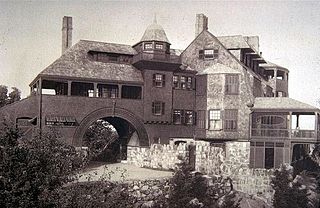
The shingle style is an American architectural style made popular by the rise of the New England school of architecture, which eschewed the highly ornamented patterns of the Eastlake style in Queen Anne architecture. In the shingle style, English influence was combined with the renewed interest in Colonial American architecture which followed the 1876 celebration of the Centennial. The plain, shingled surfaces of colonial buildings were adopted, and their massing emulated.

The Washington Park Historic District is a national historic district located in Indianapolis, Indiana. It was listed on the National Register of Historic Places on June 24, 2008. It comprises nearly 60 acres (240,000 m2) and is located 4 miles (6.4 km) north of downtown Indianapolis, in the south-central part of the Meridian-Kessler neighborhood. The district includes all properties south of 43rd Street and north of 40th Street, and west of Central Avenue and east of the alley running north and south between Pennsylvania and Meridian Streets; Washington Boulevard runs north-south through the center of the district. It includes 110 contributing buildings, ranging mostly from mansions to small bungalows, and three non-contributing buildings.

The Santa Fe Apartments were an apartment building located in Detroit, Michigan. The building was listed on the National Register of Historic Places in 1986 and subsequently demolished by Wayne State University and removed from the National Register of Historic Places in 2022. The site is now the location of the Yousif B. Ghafari Hall.

The Azalea Court Apartments is a historic three-story apartment building located in Mobile, Alabama. It was built in 1928 and was designed by architect J. Platt Roberts in the Spanish Colonial Revival style. It was added to the National Register of Historic Places on February 11, 1988.

The El Tovar Apartments is an apartment building located at 320 East Grand Boulevard in Detroit, Michigan, in the East Grand Boulevard Historic District. It was listed on the National Register of Historic Places in 1991.

The D'Iberville Apartments is a complex of historic apartment buildings located in Mobile, Alabama. They were built in 1943 to the designs of architects Harry Pembleton and Aurelius Augustus Evans. They were constructed in a Minimal Traditionalist style of architecture and are notable for their significance to the community planning and development of Mobile during World War II, a time of tremendous growth in the city. The apartments were added to the National Register of Historic Places on September 3, 2004.

The Devils Lake Masonic Temple in Devils Lake, North Dakota is a Masonic building from 1916. It was listed on the National Register of Historic Places (NRHP) in 2001.
Currently there are 124 properties listed on the National Register of Historic Places in Central Chicago, out of more than 350 listings in the City of Chicago. Central Chicago includes 3 of the 77 well-defined community areas of Chicago: the historic business and cultural center of Chicago known as the Loop, as well as the Near North Side and the Near South Side. The combined area is bounded by Lake Michigan on the east, the Chicago River on the west, North Avenue on the north, and 26th Street on the south. This area runs five and one-quarter miles from north to south and about one and one-half miles from east to west.

Silver Row is a historic site located in Provo, Utah. It is listed on the National Register of Historic Places.
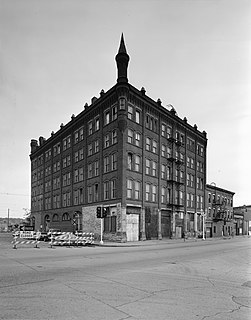
The Bishop's Block, also known as the Bishop's Block Apartments, is an historic building located in Dubuque, Iowa, United States. It was individually listed on the National Register of Historic Places in 1994. It was included as a contributing property in the Old Main Street Historic District in 2015.
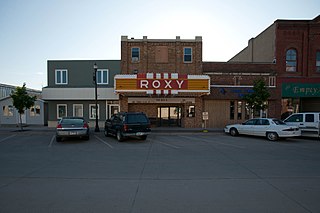
The Roxy Theatre in Langdon, North Dakota, United States, in the center of the Langdon business district, was built in 1936 in Early Commercial architecture. It was listed on the National Register of Historic Places in 1998.
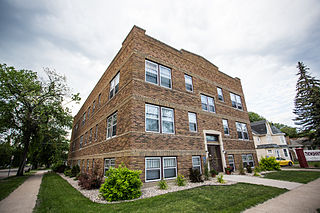
John Marshall (1864–1949) was a Scottish-born American architect in practice in Devils Lake, North Dakota from 1905 until 1946.
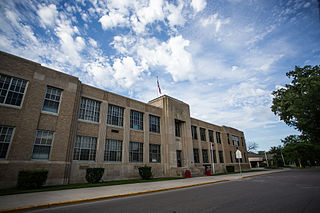
The Central Middle School on Seventh St. in Devils Lake, North Dakota was built in 1936. It was designed by architects John Marshall of Devils Lake and Nairne W. Fisher of St. Cloud, Minnesota in Art Deco style. The school was listed on the National Register of Historic Places (NRHP) in 2003 as the Central High School.

Joseph A. Shannon (1859-1934), known in at least one source as John A. Shannon, was an architect in Devils Lake, North Dakota.

The Bangs-Wineman Block on Fourth St., Devils Lake, North Dakota, USA, was built in 1895. It has also been known as Glicksons Department Store. It was listed on the National Register of Historic Places in 1985.

The Episcopal Church of the Advent-Guild Hall on 6th St. E. in Devil's Lake, North Dakota was built in 1886. It has also been known as Stone Church. It was listed on the National Register of Historic Places in 2002.
Architects of the National Park Service are the architects and landscape architects who were employed by the National Park Service (NPS) starting in 1918 to design buildings, structures, roads, trails and other features in the United States National Parks. Many of their works are listed on the National Register of Historic Places, and a number have also been designated as National Historic Landmarks.

The Alphabet Historic District, is a historic district in the Northwest District of Portland, Oregon which was listed on the National Register of Historic Places in 2000. It is 156.9 acres (63.5 ha) in area and includes 478 contributing buildings. It is roughly bounded by NW Lovejoy St., NW Marshall St., NW 17th Ave., W. Burnside St., and NW 24th Ave.





















